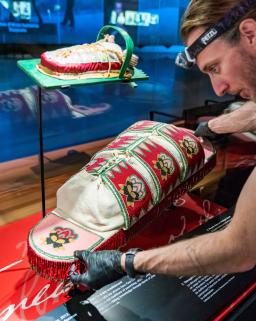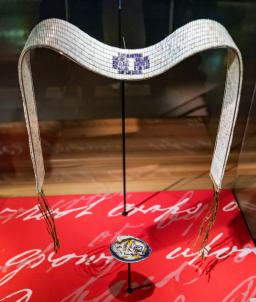This release is more than two years old
This release is more than two years old. For additional information, please contact Amanda Gaudes from our Media Relations team.
News release details
The exhibit, which presents the Indian Act as a tool of assimilation, oppression and dispossession, was created in close collaboration between the Museum and First Nations Elders and advisors, who had a direct voice in decisions about its content and physical design.
“The way these items are presented, as if floating above the Act, speaks to the resilience and survival of Indigenous traditions,” said Dana Soonias of Red Pheasant First Nation, who was a key advisor for the exhibit along with Sharon McLeod of Norway House Cree Nation – both members of the Museum’s Standing Indigenous Advisory Council (SIAC). “It reflects the ongoing fight against the original goal of the Indian Act to assimilate and eradicate First Nations in Canada.”
Dr. Karine Duhamel, the CMHR’s curator for Indigenous rights, said the exhibit is intended to provoke questions and discussions about a topic of great significance in Canada. “Many people don’t even know that the Indian Act still exists, let alone understand the negative impact it continues to have,” she said.
“The concept of ‘shared authority’ was embraced in all aspects of exhibit development, including the content, the images and the selection of what objects we would display and how they would be sourced.”
Ojibway Elder Clarence Nepinak contributed an eagle feather with beaded stem that he uses in ceremony. It is displayed alongside a feather owned by Elijah Harper – the First Nations chief and elected Manitoba politician who in 1990 famously opposed constitutional amendments of the Meech Lake Accord, citing insufficient consultation with Indigenous Peoples.
“Eagle feathers create connections between the physical and spiritual worlds; they must be able to ‘breathe’ and have the air flow around them,” said Nepinak, who is also an advisor with SIAC. “So we made sure the display area was designed to allow air circulation, meaning the feathers would not be enclosed in a sealed case. Instead, we say they are ‘lodged’ here for a while.”
The Indian Act was first introduced in 1876 as a consolidation of previous pieces of legislation. Since time immemorial, First Nations people have practiced their own cultures and traditions in all aspects of their lives, including family relationships, governance, land use and identity.
Elements of the exhibit, which will run until summer 2019, include:
A cradleboard by Cree artist Marcia Chickeness, symbolizing resilience and survival of Indigenous family traditions and knowledge, despite attempts at the assimilation under the Indian Act of successive generations of children, including residential schools.
Eagle feathers, which are commonly used in ceremony or held by leaders to represent truth, respect and balance in decision‐making under traditional methods of governance. In contrast, the Indian Act imposes governance systems and band elections that are foreign to First Nations traditions.
Wampum belt by Haohyoh (Ken Maracle), an Onondaga faith keeper, replicating the “Dish with One Spoon” treaty of the 1700s between the Haudenosaunee and the Anishinaabe. This treaty reflects principles of fairness, taking only what is needed and protecting the land under traditional negotiations for the rights of each nation to territory. In contrast, the Indian Act removed First Nations people from their lands to provide property for settlers.
Handwritten excerpts (replicas) from a set of amendments to the Indian Act in 1880, presented on red mats, intended to show the Act as an instrument of control. The colour red was chosen for the mats by elders and advisors to represent healing and the lifeblood of the people. The exhibit also includes printed excerpts from the original 1876 version of the Act.
High‐resolution photographs are available upon request.
This release is more than two years old
This release is more than two years old. For additional information, please contact Amanda Gaudes from our Media Relations team.


